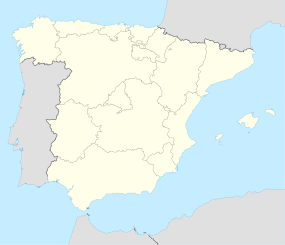Archaeological ensemble of Mérida

Roman theater in Mérida
|
|
| Location | Mérida, Extremadura, Spain |
|---|---|
| Region | Lusitania |
| Coordinates | 38°55′N 6°20′W / 38.917°N 6.333°WCoordinates: 38°55′N 6°20′W / 38.917°N 6.333°W |
| Type | Settlement |
| History | |
| Founded | 25 BC |
| Cultures | Roman |
| Official name | Archaeological Ensemble of Mérida |
| Type | Cultural |
| Criteria | iii, iv |
| Designated | 1993 (17th session) |
| Reference no. | 664 |
| State Party | Spain |
| Region | Europe and North America |
The Roman colony of Emerita Augusta (present day Mérida) was founded in 25 BC by Augustus, to resettle emeriti soldiers discharged from the Roman army from two veteran legions of the Cantabrian Wars: Legio V Alaudae and Legio X Gemina. The city was the capital of the Roman province of Lusitania.
Today the Archaeological Ensemble of Mérida is one of the largest and most extensive archaeological sites in Spain and a UNESCO World Heritage Site since 1993.
The theatre was built from 16 to 15 BC and dedicated by the consul Marcus Vipsanius Agrippa. It was renovated in the late 1st or early 2nd century AD, possibly by the emperor Trajan, and again between 330 and 340 during Constantine's reign, when a walkway around the monument and new decorative elements were added. With the advent of Christianity as Rome's sole state religion, theatrical performances were officially declared immoral: the theatre was abandoned and most of its fabric was covered with earth, leaving only its upper tiers of seats (summa cavea). In Spanish tradition, these were known as "The Seven Chairs" in which it is popularly thought that several Moorish kings held court to decide the fate of the city.
The amphitheatre was dedicated in 8 BC, for use in gladiatorial contests and staged beast-hunts. It has an elliptical arena, surrounded by tiered seating for around 15,000 spectators, divided according to the requirements of Augustan ideology; the lowest seats were reserved for the highest status spectators. Only these lowest tiers survive. Once the games had fallen into disuse, the stone of the upper tiers was quarried for use elsewhere.
The circus of Emerita Augusta was built some time around 20 BC, and was in use for many years before its dedication some thirty years later, probably during the reign of Augustus' successor, Tiberius. It was sited outside the city walls, alongside the road that connected Emeritus in Corduba (Córdoba) with Toletum (Toledo). The arena plan was of elongated U-shape, with one end semicircular and the other flattened. A lengthwise spina formed a central divide within, to provide a continuous trackway for two-horse and four-horse chariot racing. The track was surrounded by ground level cellae, with tiered stands above. At some 400m long and 100m wide, the Circus was the city's largest building, and could seat about 30,000 spectators – the city's entire population, more or less. Like most circuses throughout the Roman Empire, Mérida's resembled a scaled-down version of Rome's Circus Maximus.
...
Wikipedia

